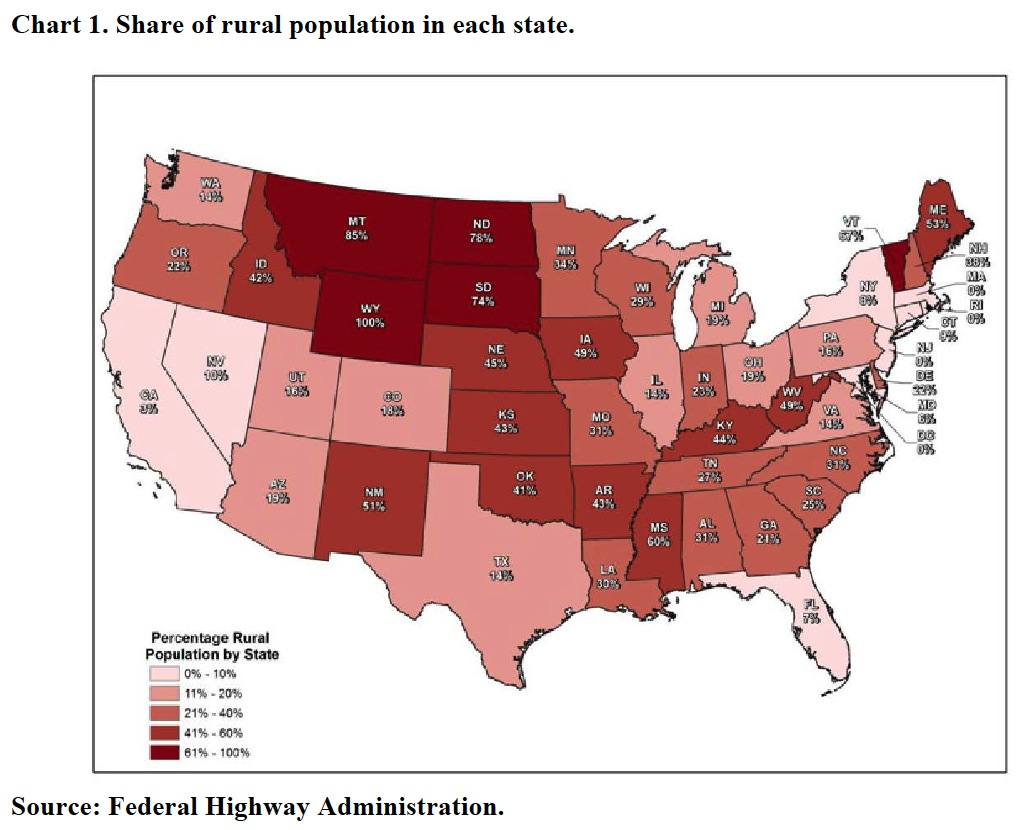TRIP
America’s rural heartland plays a vital role as home to a significant share of the nation’s population, many of its natural resources, and popular tourist destinations. It is also the primary source of the energy, food and fiber that supports America’s economy and way of life. The strength of the nation’s rural economy is heavily reliant on the quality of the transportation system, particularly the roads and highways that link rural America with the rest of the U.S. and to markets in other countries. The economy of rural America rides on the quality and connectivity of the rural transportation system, which supports quality of life for the approximately 61 million Americans living in rural areas.
Good transportation is essential to rural areas to provide access to jobs, to facilitate the movement of goods and people, to access opportunities for health care and educational skills, and to provide links to other social services. Transportation supports businesses and is a critical factor in a company’s decision to locate new business operations. For communities that rely on tourism and natural amenities to help support their economy, transportation is the key link between visitors and destinations.
Roads, highways, rails and bridges in the nation’s heartland face a number of significant challenges: they lack adequate capacity, they fail to provide needed levels of connectivity to many communities, and they are not adequate to accommodate growing freight travel in many corridors. Rural roads and bridges have significant deficiencies, they lack many desirable safety features, and they experience fatal traffic crashes at a rate far higher than all other roads and highways. This report looks at the condition, use and safety of the nation’s rural transportation system, particularly its roads, highways and bridges, and identifies needed improvements.
Rural areas in this report are based on the U.S. Census Bureau definition, which defines rural areas as regions outside of urban areas with a population of 2,500 or more. Road, bridge and safety data in this report is based on the Federal Highway Administration (FHWA) definition, which allows states to either use the U.S. Census Bureau definition to identify rural routes or to define rural areas as regions outside of urban areas with a population of 5,000 or more.
The following are the key findings of the report
An aging and increasingly diverse rural America plays a vital role as home to a significant share of the nation’s population, natural resources and tourist destinations. It is also the primary source of the energy, food and fiber that drive the U.S. economy. Rural Americans are more reliant on the quality of their transportation system than their urban counterparts.
- While there are many ways to define rural, the U.S. Census Bureau defines rural areas as regions outside of urban areas with a population of 2,500 or more.
- According to the U.S. Census Bureau definition, 19 percent of the nation’s residents live in rural areas – approximately 61 million of the nation’s 314 million people in 2014.
- America’s rural population increased gradually each year from 1976 to 2010, rising between 0.1 and 1.5 percent each year. From 2010 to 2014, the nation’s rural population declined slightly as rural areas continued to be impacted by the Great Recession.
- While overall rural populations declined slightly between 2010 and 2014, population did increase in some rural areas from 2010 to 2014. This population increase occurred primarily in rural counties that have been impacted by the ongoing energy boom, particularly in the Northern Great Plains as well as portions of Arkansas, Louisiana, Pennsylvania and Texas.
- Many of the transportation challenges facing rural America are similar to those in urbanized areas. However, rural residents tend to be more heavily reliant on their limited transportation network – primarily rural roads and highways- than their counterparts in more urban areas. Residents of rural areas often must travel longer distances to access education, employment, retail locations, social opportunities and health services.
- The rural U.S. population is aging more rapidly than the nation as a whole. The share of older adults in rural areas is disproportionate, with 17.2 percent of those living in rural areas over age 65, while 12.8 percent of residents in urban areas and 13 percent of the nation’s total population are over 65.
- Rural areas are growing increasingly more diverse. Although racial and ethnic minorities make up only 21 percent of the rural population, minorities accounted for nearly 83 percent of rural population growth between 2000 and 2010.
- The movement of retiring baby boomers to rural America is likely to continue in the future as aging Americans seek out communities that offer affordable housing, small-town quality of life and desirable natural amenities, while often located within a short drive of larger metropolitan areas.
- Eighty-six percent of trips taken by Americans to visit rural areas are for leisure purposes.
- Popular tourism activities in rural America include hiking, golfing, biking, hunting, fishing and water sports. Rural areas are also home to beaches, national and state parks, wineries, orchards and other national amenities.
- The amount of rural tourism in a region is tied partly to the level of highway access.
Download full version (PDF): Rural Connections: Challenges and Opportunities in America’s Heartland
About TRIP
www.tripnet.org
Founded in 1971, TRIP ® of Washington, DC, is a nonprofit organization that researches, evaluates and distributes economic and technical data on surface transportation issues. TRIP is sponsored by insurance companies, equipment manufacturers, distributors and suppliers; businesses involved in highway and transit engineering and construction; labor unions; and organizations concerned with efficient and safe surface transportation.







 RSS Feed
RSS Feed